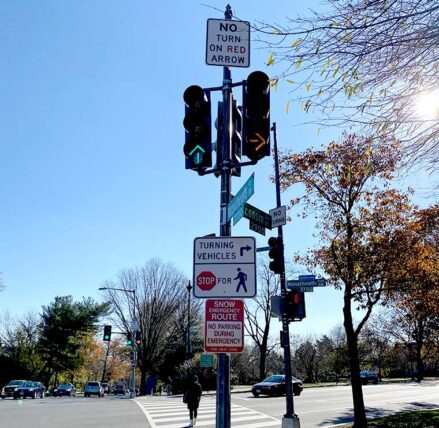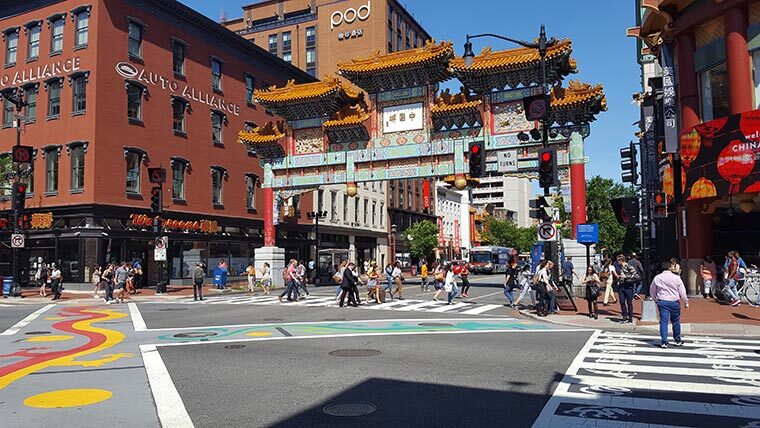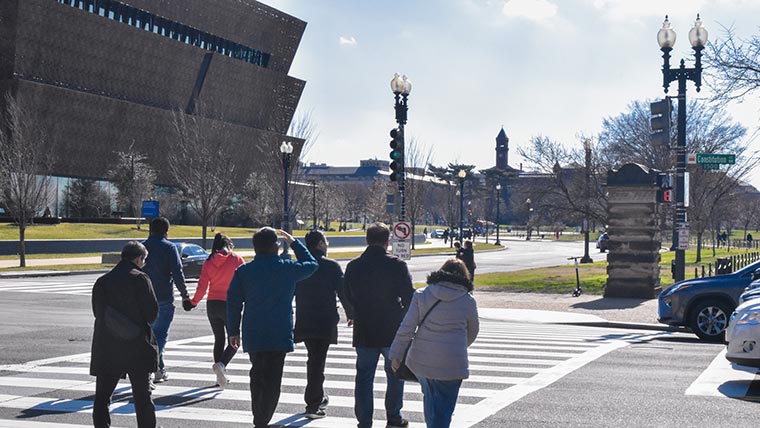The domain of the traffic signal has traditionally been automobile-centric in American transportation planning and design. In fact, the most popular traffic analysis software do not have tools to evaluate nonmotorized modes of travel, and the Federal Manual on Uniform Traffic Control Devices (MUTCD) still does not even require pedestrian-specific signals at intersections. However, with many cities both large and small encouraging alternate forms of travel, the need for guidance and tools to help accommodate and integrate these modes into traffic signal operations is quickly increasing.
The National Cooperative Highway Research Program (NCHRP) Research Report 969: Traffic Signal Control Strategies for Pedestrians and Bicyclists outlines current best practices for accommodating these modes at traffic signals. The document also provides new performance measures for nonmotorized travel. As a transportation engineer in the DC Metro Area who works daily with traffic signals, I am excited for the release of this document, because it codifies what our team and many other engineers across the country have been doing as we work to make pedestrian and bicyclist mobility safer and more accessible. One of the key ways to achieve this goal is to reduce turning conflicts at intersections for nonmotorized users.
How to reduce turning conflicts?
Turning conflicts at signalized intersections typically pose the most frequent risk to nonmotorized users, since right angle (crossing) conflicts are controlled by the traffic signal. Vehicles may not be looking for a pedestrian or bicyclist to their left or right, especially if they are looking for gaps in opposing traffic. The following signal treatments, included in NCHRP 969, can all be used to improve safety of pedestrians and cyclists at intersections:
Leading Pedestrian Intervals (LPIs)
This simple but effective timing tool gives pedestrians a short head start before any vehicles are allowed to enter the intersection. With only minor impacts to vehicle delays, this treatment makes pedestrians more visible and establishes their right-of-way to cross. Because it can be relatively easy to implement, depending on the traffic controller and central control configuration, our team has assisted the District with implementing over 900 LPIs in the last four years.

Delayed Turn/Leading Thru Intervals
This upgraded or enhanced LPI can be implemented at intersections with dedicated turn lanes. These turn bays can be used to hold turning vehicles for longer than a typical LPI, while thru traffic is allowed to start immediately with the pedestrian or bicyclist movements. The benefit of this over a traditional LPI is that delay impacts are completely mitigated for thru traffic. In DC, some local examples of this treatment are the intersections of Wisconsin Ave and Massachusetts Ave NW or 14th St and H St NE. At these locations, mainline right turns are finally permitted after the Leading Thru Interval to turn using Flashing Yellow Arrow displays – this designates that, even when they are allowed to turn, vehicles must yield to pedestrians in the crosswalk.

Exclusive Pedestrian Phases or Barnes Dances
Also known as a pedestrian scramble, this dedicated phase allows all pedestrian movements to cross simultaneously. Under a Barnes Dance configuration, even the diagonal pedestrian movements through the intersection are allowed. As a completely separate phase is required, this treatment increases delay for all users – pedestrians and bicyclists included – so it is not suited to all intersections. However, in the right circumstances, it can be effective in improving safety as long as pedestrian compliance with the dedicated phase can be achieved. As NCHRP notes, pedestrian compliance with traffic signal indications increases as delay increases. Therefore, it is important in these exclusive pedestrian phase implementations that overall pedestrian delay is kept to a reasonable amount and that pedestrians perceive the safety need and benefit of having dedicated crossings. In DC, several applications of this tool are located near high-volume transit stations (e.g., 7th Street and H Street NW), and near schools where time-of-day all-pedestrian phases are used (e.g., 34th Street and Lowell Street NW).

Up until this point, the latest treatments for pedestrians and bicyclists have been spread across many different resources. The NCHRP Report 969 synthesizes all the best practices for nonmotorized mobility at signalized intersections and provides a one-stop shop for the latest guidance. The report details many treatments and gives in-depth information such as applications, examples, and further considerations, and I highly recommend it as a resource to anyone who wants to improve the experience of nonmotorized users at traffic signals in their community.
Reducing turning conflicts is just one facet of increasing the safety of nonmotorized users at signalized intersections. I will be discussing several others in upcoming blogs – stay tuned!
Read Part 2: Reducing Delay for Nonmotorized Users – NCHRP Report 969 in Practice
Read Part 3: Addressing Bicycle-Specific Needs – NCHRP Report 969 In Practice



